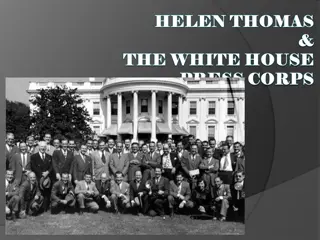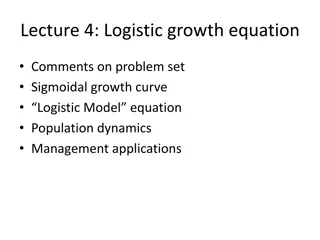
Evolution and Development of Television Journalism
Explore the evolution and development of television journalism, from its inception by John Baird to the establishment of broadcasting services by BBC and CBS. Learn how television became a powerful medium for education, information, and entertainment globally, including its impact on India with the introduction of experimental TV broadcasts in 1959 and initiatives like the Satellite Instructional Television Experiment (SITE) to promote educational programs in rural areas.
Uploaded on | 0 Views
Download Presentation

Please find below an Image/Link to download the presentation.
The content on the website is provided AS IS for your information and personal use only. It may not be sold, licensed, or shared on other websites without obtaining consent from the author. If you encounter any issues during the download, it is possible that the publisher has removed the file from their server.
You are allowed to download the files provided on this website for personal or commercial use, subject to the condition that they are used lawfully. All files are the property of their respective owners.
The content on the website is provided AS IS for your information and personal use only. It may not be sold, licensed, or shared on other websites without obtaining consent from the author.
E N D
Presentation Transcript
TV JOURNALISM By- Dr. Rashmi Gautam Assistant Professor, DJMC, CSJMU Kanpur
Evolution and Development of Television Radio, print and cinema were already there before the arrival of television. The idea of television existed long before the actual invention of television. Several inventors were working on the creation of a technology which could transmit sound as well as visuals. John Baird is generally regarded as the father of television. British Broadcasting Corporation (BBC) of Britain began the first television service in 1936. If you have a satellite or cable connection, you will be able to watch BBC, the world s oldest television broadcaster. By 1939, television broadcasts began in the United States also. These two countries were clearly ahead in the race. Other countries began television broadcasting on a wide scale only by the 1950s
The early television broadcasts were all black and white. The first successful programme in colour was transmitted by Columbia Broadcasting System (CBS) in USA in 1953. The television set became one of the important mediums of entertainment with the advent of several popular shows. Television gradually matured as a medium during the next two decades. 1936-British Broadcasting Corporation (BBC) of Britain began the first television service of the world 1939-Television broadcasts began in US 1950s -Other countries began television broadcasting on a wide scale 1953-The first successful programme in colour was transmitted by CBS in USA In today s world, television has become one of the most powerful means of mass communication. It can impart Education, Information And Entertainment. Television has become an integral part of our lives. In the next section you will learn about the of history of television in India.
Television began in India on 15th September 1959 as an experiment. There were only one-hour programmes a week, each of one hour duration. Imagine a television set working for only two hours a week. The early programmes on these experimental broadcasts were generally educational programmes for school children and farmers. Several community television sets were set up in Delhi s rural areas and schools around Delhi for the dissemination of these programmes. By the 1970s, television centers were opened in other parts of the country also. In 1976, Doordarshan, which was All India Radio s television arm until then became a separate department. 1959- Television Began In India OnAn Experimental Basis 1975-1976 Satellite Instructional Television Experiment (Site) 1976-Doordarshan Became ASeparate Department Independent Of All India Radio (AIR)
Several community television sets were distributed as a part of the important landmarks in the history of Indian television. Satellite Instructional Television Experiment (SITE) was conducted between August 1975 and July 1976. Under this programme, the Indian government used the American Television satellite ATS-6 to broadcast educational programmes to Indian villages. Six states were selected for this experiment and television sets. SITE was an important step taken by India to use television for development. the programmes were mainly produced by Doordarshan which was then a part of air. the telecasts happened twice a day, in the morning and evening. other than agricultural information, health and family planning were the other important topics dealt with in these programmes. entertainment was also included in these telecasts in the form of dance, music, drama, folk and rural art forms.
A major milestone in the history of Indian television was the coverage of the Ninth Asian Games in 1982. Doordarshan provided National coverage for the first time through the satellite INSAT-1A. Also, for the first time, the transmission was in colour. In addition to the domestic transmission, Doordarshan was also providing content for the broadcasters of many other countries. After 1982, there was a huge increase in the live coverage of sports by Doordarshan. 1982-Doordarshan provided National coverage for the first time through the satellite INSAT-1A. 1983-Government sanctions huge expansion of Doordarshan. In 1997, Prasar Bharati, a statutory autonomous body was established. Doordarshan along with AIR was converted into government corporations under Prasar Bharati. 1997- establishment of Prasar Bharati.
1959-Television started in India as an experiment. 1975-SITE programme starts. 1976-Doordarshan, which was AIR s television arm, becomes a separate department. 1982-Coverage of Ninth Asian Games. Doordarshan starts national coverage and colour transmission for the first time. 1983-Government sanctions a huge expansion of Doordarshan. 1997-Establishment of Prasar Bharat. Doordarshan has grown into a major television broadcaster with around 30 channels. This includes Regional Language Satellite Channels, State Networks, International Channel and All India Channels like DD National, DD News, DD Sports, DD Gyandarshan, DD Bharati, Loksabha Channel and DD Urdu.






















